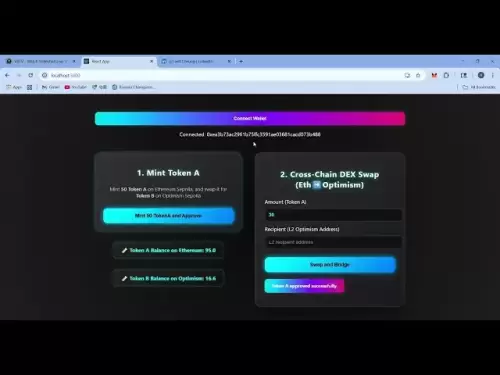-
 Bitcoin
Bitcoin $109,459.7682
2.44% -
 Ethereum
Ethereum $2,598.6052
6.29% -
 Tether USDt
Tether USDt $1.0003
0.00% -
 XRP
XRP $2.2734
3.95% -
 BNB
BNB $661.4886
1.58% -
 Solana
Solana $155.4825
4.35% -
 USDC
USDC $0.9999
-0.02% -
 TRON
TRON $0.2838
1.04% -
 Dogecoin
Dogecoin $0.1740
8.25% -
 Cardano
Cardano $0.6047
9.04% -
 Hyperliquid
Hyperliquid $40.2302
6.50% -
 Sui
Sui $2.9863
10.05% -
 Bitcoin Cash
Bitcoin Cash $509.5786
0.60% -
 Chainlink
Chainlink $13.8156
6.03% -
 UNUS SED LEO
UNUS SED LEO $9.0142
0.69% -
 Avalanche
Avalanche $19.0337
8.68% -
 Stellar
Stellar $0.2438
5.17% -
 Toncoin
Toncoin $2.9012
3.59% -
 Shiba Inu
Shiba Inu $0.0...01210
6.20% -
 Litecoin
Litecoin $90.0882
7.05% -
 Hedera
Hedera $0.1597
8.53% -
 Monero
Monero $326.3340
2.88% -
 Polkadot
Polkadot $3.6365
9.32% -
 Bitget Token
Bitget Token $4.6162
2.72% -
 Dai
Dai $1.0001
0.00% -
 Ethena USDe
Ethena USDe $1.0002
-0.01% -
 Uniswap
Uniswap $7.6403
10.47% -
 Pepe
Pepe $0.0...01060
12.03% -
 Aave
Aave $281.3664
7.56% -
 Pi
Pi $0.4992
1.76%
How to blow up Bitcoin contract
Blowing up a Bitcoin contract refers to incurring significant losses due to adverse price movements or poor risk management.
Nov 19, 2024 at 07:23 am

How to Blow Up a Bitcoin Contract
Blowing up a Bitcoin contract refers to incurring significant losses due to adverse price movements or poor risk management. This can result in a substantial financial setback or even the complete loss of your capital. While trading Bitcoin contracts can be lucrative, it's crucial to understand the risks and adopt strategies to mitigate potential losses. In this comprehensive guide, we will delve into the intricacies of Bitcoin contract trading, exploring common pitfalls and providing practical tips to help you navigate the market successfully.
Understanding Bitcoin Contracts
Bitcoin contracts are financial instruments that allow traders to speculate on the future price of Bitcoin without owning the underlying asset. These contracts are typically traded on exchanges and provide leverage, enabling traders to amplify their profits or losses. However, leverage is a double-edged sword, and traders must exercise caution when using it.
Common Mistakes That Lead to Blowing Up Bitcoin Contracts
Several common mistakes can lead to significant losses or even the complete loss of capital when trading Bitcoin contracts. These include:
1. Overleveraging
Overleveraging is one of the most prevalent mistakes among novice traders. When leveraged, traders can control a larger position size with a smaller amount of capital. However, this increases their exposure to risk, and even a slight adverse price movement can result in substantial losses.
2. Poor Risk Management
Inadequate risk management is another major pitfall for Bitcoin contract traders. This includes failing to set stop-loss orders, which automatically close positions when they reach a predetermined price level, and not having a sound trading plan that outlines entry and exit strategies.
3. Emotional Trading
Letting emotions guide trading decisions is a common mistake that can lead to irrational behavior. Traders may hold losing positions too long or chase after profits, ultimately increasing their losses. Maintaining objectivity and sticking to a trading plan is essential.
4. Lack of Understanding
Thoroughly understanding Bitcoin contract trading is crucial for success. This includes grasping the concepts of leverage, margin, and the different types of orders available. Without a solid foundation, traders may make uninformed decisions that can have detrimental consequences.
Strategies to Mitigate Losses
To mitigate potential losses when trading Bitcoin contracts, traders should adopt the following strategies:
1. Determine an Appropriate Leverage Level
Selecting a suitable leverage level is critical. Leverage should be used cautiously and only within a trader's risk tolerance. Starting with a low leverage level and gradually increasing it as experience and knowledge grow is advisable.
2. Implement Stop-Loss Orders
Stop-loss orders are a valuable risk management tool. They protect traders from catastrophic losses by automatically closing positions when they reach a predefined price level. Traders should set stop-loss orders below critical support levels to limit potential losses.
3. Create a Trading Plan
Developing a trading plan is crucial for success. It should outline entry and exit strategies, identify risk tolerance, and establish clear trading rules. Adhering to a trading plan helps traders make objective decisions and avoid emotional trading.
4. Educate Yourself
Continuously educating oneself about Bitcoin contract trading is essential. This includes studying market trends, technical analysis, and risk management techniques. The more knowledgeable traders are, the better equipped they will be to navigate the market and make informed decisions.
Conclusion
Blowing up a Bitcoin contract can be a devastating experience, but it can be avoided by adopting sound trading practices. Understanding the risks, using appropriate leverage, implementing risk management strategies, and continuously educating oneself are crucial for success. Remember, trading Bitcoin contracts involves a high level of risk, and traders should only invest what they can afford to lose.
Disclaimer:info@kdj.com
The information provided is not trading advice. kdj.com does not assume any responsibility for any investments made based on the information provided in this article. Cryptocurrencies are highly volatile and it is highly recommended that you invest with caution after thorough research!
If you believe that the content used on this website infringes your copyright, please contact us immediately (info@kdj.com) and we will delete it promptly.
- Eurau Stablecoin: Deutsche Bank, Galaxy, and Bafin Approval Usher in New Era
- 2025-07-03 20:30:12
- Solana DEX Volume and Ranking: Riding the Wave to the Top
- 2025-07-03 21:10:20
- BONK ETF Buzz: News, Catalysts, and What's Driving the Meme Coin Mania
- 2025-07-03 21:10:20
- Check Your Change! That 1p Coin Could Be Worth £200k!
- 2025-07-03 21:20:17
- Mosman Oil's Vecta Termination: A Drilling Programme Debrief
- 2025-07-03 20:30:12
- HYPE Price Forecast: Will It Reach $50 by July 2025?
- 2025-07-03 21:20:18
Related knowledge

How to identify the contract value range in combination with the market profile?
Jul 02,2025 at 10:56pm
Understanding the Market ProfileTo effectively identify the contract value range in combination with the market profile, it's essential to first understand what each concept entails. The market profile is a framework that helps traders visualize how price and time interact across a given period, typically a trading day or session. It provides insights i...

How to use the price slope to filter the false breakthrough signal of the contract?
Jun 20,2025 at 06:56pm
Understanding the Concept of Price Slope in Contract TradingIn contract trading, especially within cryptocurrency derivatives markets, price slope refers to the rate at which the price changes over a specific time period. It helps traders assess the strength and sustainability of a trend. A steep slope may indicate strong momentum, while a shallow slope...

How to determine the expected volatility of the contract through the volatility cone?
Jun 19,2025 at 12:28pm
Understanding the Basics of Volatility in Cryptocurrency ContractsIn the realm of cryptocurrency trading, volatility is a key metric that traders use to assess potential risk and reward. When dealing with futures contracts, understanding how volatile an asset might become over time is crucial for position sizing, risk management, and strategy developmen...

How to formulate a contract intraday trading plan in combination with the pivot point system?
Jun 21,2025 at 03:42pm
Understanding the Basics of Pivot Points in Cryptocurrency TradingPivot points are technical analysis tools used by traders to identify potential support and resistance levels. These levels are calculated using the previous day's high, low, and closing prices. In the context of cryptocurrency trading, where markets operate 24/7, pivot points help trader...

How to adjust the contract position ratio through the price fluctuation entropy?
Jun 22,2025 at 11:42am
Understanding Price Fluctuation Entropy in Cryptocurrency ContractsIn the world of cryptocurrency futures trading, price fluctuation entropy is a relatively new concept used to measure market volatility and uncertainty. It derives from information theory, where entropy refers to the degree of randomness or unpredictability in a system. In crypto contrac...

How to use the volume swing indicator to predict the contract volume-price divergence?
Jun 18,2025 at 11:42pm
Understanding the Volume Swing IndicatorThe volume swing indicator is a technical analysis tool used primarily in cryptocurrency trading to evaluate changes in volume over time. Unlike price-based indicators, this metric focuses solely on trading volume, which can provide early signals about potential market reversals or continuations. The key idea behi...

How to identify the contract value range in combination with the market profile?
Jul 02,2025 at 10:56pm
Understanding the Market ProfileTo effectively identify the contract value range in combination with the market profile, it's essential to first understand what each concept entails. The market profile is a framework that helps traders visualize how price and time interact across a given period, typically a trading day or session. It provides insights i...

How to use the price slope to filter the false breakthrough signal of the contract?
Jun 20,2025 at 06:56pm
Understanding the Concept of Price Slope in Contract TradingIn contract trading, especially within cryptocurrency derivatives markets, price slope refers to the rate at which the price changes over a specific time period. It helps traders assess the strength and sustainability of a trend. A steep slope may indicate strong momentum, while a shallow slope...

How to determine the expected volatility of the contract through the volatility cone?
Jun 19,2025 at 12:28pm
Understanding the Basics of Volatility in Cryptocurrency ContractsIn the realm of cryptocurrency trading, volatility is a key metric that traders use to assess potential risk and reward. When dealing with futures contracts, understanding how volatile an asset might become over time is crucial for position sizing, risk management, and strategy developmen...

How to formulate a contract intraday trading plan in combination with the pivot point system?
Jun 21,2025 at 03:42pm
Understanding the Basics of Pivot Points in Cryptocurrency TradingPivot points are technical analysis tools used by traders to identify potential support and resistance levels. These levels are calculated using the previous day's high, low, and closing prices. In the context of cryptocurrency trading, where markets operate 24/7, pivot points help trader...

How to adjust the contract position ratio through the price fluctuation entropy?
Jun 22,2025 at 11:42am
Understanding Price Fluctuation Entropy in Cryptocurrency ContractsIn the world of cryptocurrency futures trading, price fluctuation entropy is a relatively new concept used to measure market volatility and uncertainty. It derives from information theory, where entropy refers to the degree of randomness or unpredictability in a system. In crypto contrac...

How to use the volume swing indicator to predict the contract volume-price divergence?
Jun 18,2025 at 11:42pm
Understanding the Volume Swing IndicatorThe volume swing indicator is a technical analysis tool used primarily in cryptocurrency trading to evaluate changes in volume over time. Unlike price-based indicators, this metric focuses solely on trading volume, which can provide early signals about potential market reversals or continuations. The key idea behi...
See all articles

























































































